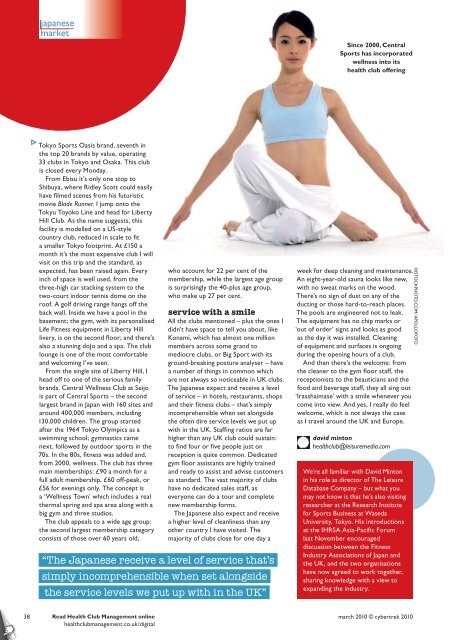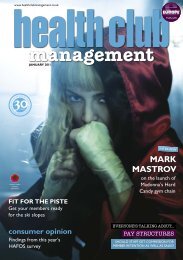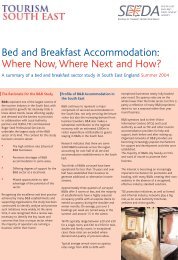Leisure Media HCM March 2010 - TourismInsights
Leisure Media HCM March 2010 - TourismInsights
Leisure Media HCM March 2010 - TourismInsights
Create successful ePaper yourself
Turn your PDF publications into a flip-book with our unique Google optimized e-Paper software.
japanese<br />
market<br />
Since 2000, Central<br />
Sports has incorporated<br />
wellness into its<br />
health club offering<br />
Tokyo Sports Oasis brand, seventh in<br />
the top 20 brands by value, operating<br />
33 clubs in Tokyo and Osaka. This club<br />
is closed every Monday.<br />
From Ebisu it’s only one stop to<br />
Shibuya, where Ridley Scott could easily<br />
have fi lmed scenes from his futuristic<br />
movie Blade Runner. I jump onto the<br />
Tokyu Toyoko Line and head for Liberty<br />
Hill Club. As the name suggests, this<br />
facility is modelled on a US-style<br />
country club, reduced in scale to fi t<br />
a smaller Tokyo footprint. At £150 a<br />
month it’s the most expensive club I will<br />
visit on this trip and the standard, as<br />
expected, has been raised again. Every<br />
inch of space is well used, from the<br />
three-high car stacking system to the<br />
two-court indoor tennis dome on the<br />
roof. A golf driving range hangs off the<br />
back wall. Inside we have a pool in the<br />
basement; the gym, with its personalised<br />
Life Fitness equipment in Liberty Hill<br />
livery, is on the second fl oor; and there’s<br />
also a stunning doJo and a spa. The club<br />
lounge is one of the most comfortable<br />
and welcoming I’ve seen.<br />
From the single site of Liberty Hill, I<br />
head off to one of the serious family<br />
brands. Central Wellness Club at Seijo<br />
is part of Central Sports – the second<br />
largest brand in Japan with 160 sites and<br />
around 400,000 members, including<br />
130,000 children. The group started<br />
after the 1964 Tokyo Olympics as a<br />
swimming school; gymnastics came<br />
next, followed by outdoor sports in the<br />
70s. In the 80s, fi tness was added and,<br />
from 2000, wellness. The club has three<br />
main memberships: £90 a month for a<br />
full adult membership, £60 off-peak, or<br />
£56 for evenings only. The concept is<br />
a ‘Wellness Town’ which includes a real<br />
thermal spring and spa area along with a<br />
big gym and three studios.<br />
The club appeals to a wide age group:<br />
the second largest membership category<br />
consists of those over 60 years old,<br />
who account for 22 per cent of the<br />
membership, while the largest age group<br />
is surprisingly the 40-plus age group,<br />
who make up 27 per cent.<br />
service with a smile<br />
All the clubs mentioned – plus the ones I<br />
didn’t have space to tell you about, like<br />
Konami, which has almost one million<br />
members across some grand to<br />
mediocre clubs, or Big Sport with its<br />
ground-breaking posture analyser – have<br />
a number of things in common which<br />
are not always so noticeable in UK clubs.<br />
The Japanese expect and receive a level<br />
of service – in hotels, restaurants, shops<br />
and their fitness clubs – that’s simply<br />
incomprehensible when set alongside<br />
the often dire service levels we put up<br />
with in the UK. Staffing ratios are far<br />
higher than any UK club could sustain:<br />
to find four or five people just on<br />
reception is quite common. Dedicated<br />
gym floor assistants are highly trained<br />
and ready to assist and advise customers<br />
as standard. The vast majority of clubs<br />
have no dedicated sales staff, as<br />
everyone can do a tour and complete<br />
new membership forms.<br />
The Japanese also expect and receive<br />
a higher level of cleanliness than any<br />
other country I have visited. The<br />
majority of clubs close for one day a<br />
“The Japanese receive a level of service that’s<br />
simply incomprehensible when set alongside<br />
the service levels we put up with in the UK”<br />
week for deep cleaning and maintenance.<br />
An eight-year-old sauna looks like new,<br />
with no sweat marks on the wood.<br />
There’s no sign of dust on any of the<br />
ducting or those hard-to-reach places.<br />
The pools are engineered not to leak.<br />
The equipment has no chip marks or<br />
‘out of order’ signs and looks as good<br />
as the day it was installed. Cleaning<br />
of equipment and surfaces is ongoing<br />
during the opening hours of a club.<br />
And then there’s the welcome: from<br />
the cleaner to the gym fl oor staff, the<br />
receptionists to the beauticians and the<br />
food and beverage staff, they all sing out<br />
‘Irasshaimase’ with a smile whenever you<br />
come into view. And yes, I really do feel<br />
welcome, which is not always the case<br />
as I travel around the UK and Europe.<br />
david minton<br />
healthclub@leisuremedia.com<br />
We’re all familiar with David Minton<br />
in his role as director of The <strong>Leisure</strong><br />
Database Company – but what you<br />
may not know is that he’s also visiting<br />
researcher at the Research Institute<br />
for Sports Business at Waseda<br />
University, Tokyo. His introductions<br />
at the IHRSA Asia-Pacific Forum<br />
last November encouraged<br />
discussion between the Fitness<br />
Industry Associations of Japan and<br />
the UK, and the two organisations<br />
have now agreed to work together,<br />
sharing knowledge with a view to<br />
expanding the industry.<br />
©ISTOCKPHOTO.COM/ APOLLOFOTO<br />
38<br />
Read Health Club Management online<br />
healthclubmanagement.co.uk/digital<br />
march <strong>2010</strong> © cybertrek <strong>2010</strong>
















